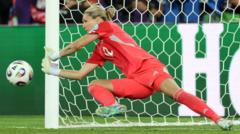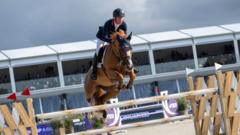Why Are Penalties Being Missed at Euro 2025? Pressure and Goalkeeper Skills at Play!

The Changing Landscape of Penalty Shootouts in Women's Football
In recent years, penalty shootouts in women's football have garnered increased attention, particularly during major tournaments such as the UEFA Women’s Euro 2025. The dramatic and tension-filled atmosphere surrounding these shootouts often leads to unexpected outcomes—outcomes that can shape the trajectory of a team's tournament journey. The recent shootout between England and Sweden is a prime example, showcasing a significant dip in the success rate of penalties taken during the tournament.
With a mere 35.7% conversion rate during the England versus Sweden shootout, it is crucial to explore the factors contributing to this anomaly. This article delves into the statistics, psychological pressures, and evolving techniques that influence penalty-taking in women's football today.
The Statistics of Euro 2025 Penalties
The Euro 2025 tournament has witnessed a remarkable decline in penalty success rates. With only five out of 14 penalties scored during the England-Sweden match, the overall tournament average stands at 58.5%, the lowest recorded in women's competitions over the past 15 years. In stark contrast, historical data shows that penalties were converted at a rate of 84.4% during the 2015 Women's World Cup. This data raises the question: why the sudden drop?
Comparative Analysis: Women's vs. Men's Penalties
Analyzing data from major tournaments from 2011 to Euro 2025 reveals that the success rate for penalties in women's tournaments was approximately 72.99%. This statistic is slightly higher than the 70.56% success rate observed in men's competitions since 2010. The evolving dynamics of women's football, including increased visibility and professionalization, may be contributing to this shift.
Psychological Pressures: The Burden of Expectations
As women's football garners more attention, the pressure on players to perform has escalated. Geir Jordet, a professor at the Norwegian School of Sports Science, emphasizes the psychological aspects of penalty taking. Research indicates that heightened pressure often leads to decreased performance levels. The surge in media coverage and fan engagement creates an environment where players are more susceptible to performance anxiety.
Experience Under Pressure
Chloe Kelly, an England forward, notes that their team's ability to handle pressure has been critical to their success in shootouts. Under the management of Sarina Wiegman, England has triumphed in all three of their shootouts, demonstrating resilience and composure under stress. This factor is vital as teams face increasingly high-stakes situations in knockout rounds.
Technological Advancements in Goalkeeping
In addition to psychological factors, advancements in goalkeeping techniques and strategies play a pivotal role in the outcome of penalty shootouts. Goalkeepers are now better equipped to analyze penalty takers, often studying their styles and tendencies. For instance, Sweden's goalkeeper Jennifer Falk had a list of England's penalty takers attached to her water bottle, allowing her to prepare for their potential shots.
The Role of Scouting and Analysis
With the advent of data analysis, goalkeepers have access to comprehensive scouting reports on their opponents. This increased awareness can lead to improved save rates during shootouts, as seen in the Euro 2025 tournament. Goalkeepers such as Falk and England's Hannah Hampton have demonstrated exceptional skill in saving penalties, further emphasizing the importance of preparation and strategy.
Preparation: The Key to Success
While some teams, like Sweden, may downplay the significance of penalty practice, England's approach highlights the necessity of preparation. Leah Williamson, the England captain, stated that extensive training for penalties is crucial in a tournament setting. This dedicated practice helps players develop confidence and consistency, ultimately improving their performance during high-pressure situations.
Physical Capability of Female Goalkeepers
Jordet also notes that the physical capabilities of female goalkeepers have improved significantly, allowing them to make more saves during penalty shootouts. Historically, the development of goalkeeping in women's football has lagged behind that of men's football, but this is changing as more resources are invested in training and development.
Adapting Penalty Techniques
The evolution of penalty-taking techniques is another factor contributing to the outcomes of shootouts. Traditionally, players have relied on specific styles of taking penalties. However, as the women's game continues to professionalize, there is an increasing emphasis on adaptability and strategy. Techniques such as the "keeper-dependent technique," where players observe the goalkeeper's movements before deciding where to shoot, are gaining traction.
Case Studies of Penalty Techniques
During the England-Sweden shootout, none of the 14 takers utilized the keeper-dependent technique, resulting in predictable penalties. This lack of variability could have contributed to the high number of saves and misses. However, as players become more aware of these strategies, we can expect to see a shift towards more sophisticated penalty-taking styles in future competitions.
Understanding the Lottery of Penalties
Despite advancements in technique and preparation, there remains an element of luck inherent to penalty shootouts. Jordet highlights that, ultimately, penalties can be a lottery. Factors such as timing, player confidence, and even the psychological state of both the shooter and the goalkeeper can influence outcomes. As teams continue to adapt and improve, the unpredictability of penalties will likely persist.
The Future of Penalty Shootouts in Women's Football
As women's football continues to evolve, the landscape of penalty shootouts is likely to transform. With improved training, increased visibility, and better goalkeeping, we may see higher success rates in the coming years. However, the psychological pressures and unpredictable nature of penalties will always remain a fascinating aspect of the game.
Conclusion: The Thrill of the Penalty Shootout
In conclusion, the dramatic penalty shootouts witnessed in Euro 2025 highlight the complexities of the modern game. Factors such as psychological pressure, technological advancements in goalkeeping, and evolving penalty techniques all play a critical role in the outcomes of these high-stakes situations. As women's football continues to rise, fans can expect even more thrilling moments in the future.
FAQs
What factors contribute to lower penalty success rates in women's football?
Lower success rates can be attributed to psychological pressures, increased scrutiny, and enhanced goalkeeping techniques. The growing popularity of women's football adds pressure, which can affect performance during shootouts.
How do goalkeepers prepare for penalty shootouts?
Goalkeepers often study their opponents' shooting styles using data analysis and scouting reports. This preparation helps them anticipate where the ball might be placed, increasing their chances of making a save.
Are penalties in women's football becoming more sophisticated?
Yes, as players gain more experience and training, we are seeing a shift toward more adaptable and strategic penalty-taking techniques, which can enhance their success rates during shootouts.
What do you think the future holds for penalty shootouts in women's football? Will we see a return to higher success rates, or will the unpredictability continue? #WomensFootball #PenaltyShootouts #Euro2025
```Published: 2025-07-20 12:16:02 | Category: sport



